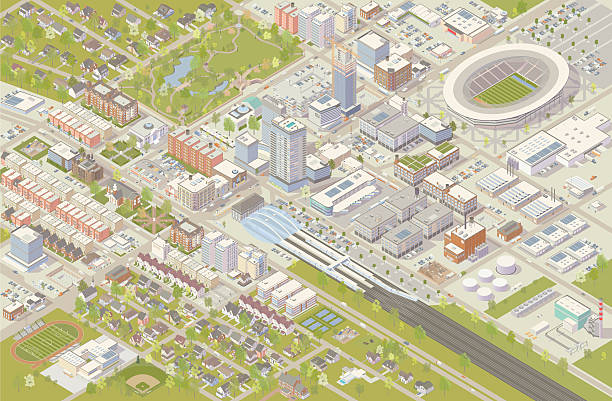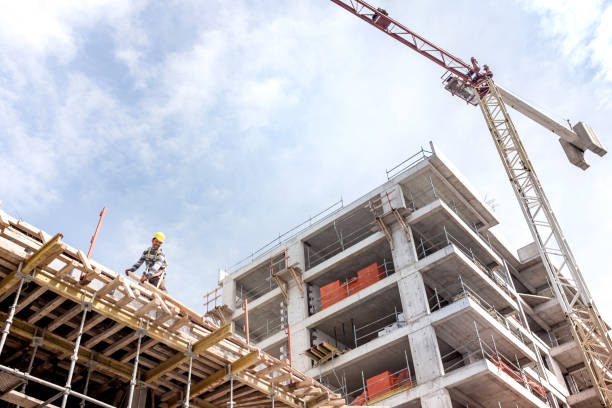Setbacks, Height Limits, and Buildable Area in Los Angeles: Essential Insights for Developers
If you’re planning a project in Los Angeles, you’ll quickly run into three recurring terms: setbacks, height limits, and buildable area. These aren’t just technical words in the zoning code—they’re the rules that shape what you can and cannot do with your property.
Table of Contents
ToggleAt JDJ Consulting Group, we work with clients who want to understand these limits before they commit serious money. Whether you’re building a custom home, adding multifamily units, or considering a commercial development, knowing these basics saves time, reduces risk, and keeps your project moving forward.
In this guide, we’ll break down each of these regulations, explain how they fit together, and show where expert guidance makes all the difference.
Understanding Zoning Essentials in Los Angeles
Before diving into setbacks or height restrictions, it’s important to know where these rules come from. In Los Angeles, almost every development question begins with the zoning code.
The zoning code tells you:
What type of building can go on your lot (single-family, multifamily, mixed-use, commercial).
How tall it can be and how far it must sit from the property line.
How dense the project can be (measured by floor area ratio, or FAR).
Which overlays or special rules might apply (for example, Specific Plans or Historic Preservation Zones).

What Is a Zoning Code and Why It Matters
Think of zoning as the city’s way of balancing growth and community needs. For property owners, it’s both a restriction and an opportunity. If you don’t know the rules, your design might need costly revisions later. But if you understand the code early, you can plan a project that meets both your goals and the city’s requirements.
This is where JDJ’s feasibility reports come in—we interpret the zoning code, map out the development envelope, and highlight where you have flexibility.
Zones, Height Districts, and Overlay Controls
Los Angeles zoning isn’t one-size-fits-all. A property in Hollywood may face different rules than one in Pacific Palisades, even if they’re both residential. That’s because each lot belongs to a zone category and sometimes a height district or overlay zone.
Here’s a simple breakdown:
| Zoning Element | What It Means | Why It Matters |
|---|---|---|
| Base Zone (e.g., R1, C2) | Defines land use—residential, commercial, industrial, or mixed. | Tells you what type of building you can propose. |
| Height District | Sets maximum stories, FAR, and building height. | Limits total size and massing of the project. |
| Overlay Zone | Adds extra requirements (design rules, use restrictions, density bonuses). | Can reduce flexibility—or create opportunities if used strategically. |
| Specific Plan | Area-specific rules for character, density, and design. | Stronger than base zoning—must comply even if stricter. |
When JDJ analyzes a property, we don’t just look at the base zoning. We review overlays, Specific Plans, and past entitlements to give a realistic picture of what’s possible.
Setbacks in Los Angeles Development
Now let’s look at setbacks, one of the most basic but powerful zoning tools. A setback is the minimum distance a building must sit from the property line. These rules shape the building footprint and the usable outdoor space.
For example, even if your lot measures 50 feet wide, you may only be able to build on 40 feet of it if the city requires a 5-foot side yard on each side.
Standard Setback Requirements by Zone Type
Every zone in Los Angeles has its own setback rules. Residential zones often have deeper front yards, while multifamily or commercial zones allow buildings closer to the street.
Here’s a general guide to common setbacks in LA:
| Zone Type | Front Yard | Side Yard | Rear Yard |
|---|---|---|---|
| Single-Family (R1) | 20 ft | 5 ft | 15 ft |
| Small Lot (RD/RS) | 15–20 ft | 4–6 ft | 15 ft |
| Multi-Family (R3, R4) | 15 ft | 5–10 ft | 15–20 ft |
| Commercial (C2, C4) | 0–5 ft | None–5 ft | 10–15 ft |
(Exact requirements vary by location, overlays, and lot size. Always confirm with ZIMAS or LADBS.)
Why Setbacks Matter for Your Project
Setbacks influence far more than where walls are placed. They affect:
Design flexibility – The shape and depth of usable interior space.
Land value – More buildable width often equals higher returns.
Privacy and sunlight – Especially in multifamily zones, setbacks protect access to light and air.
Parking layouts – Driveway placement and garage design often depend on yard widths.
At JDJ, we help clients map the “buildable envelope”—the actual 3D box available after setbacks and height rules are applied. This saves architects from designing something that will get rejected by the city.
Navigating Height Limits in Los Angeles
After setbacks, the next big rule every project faces is height limits. In Los Angeles, how tall you can build depends on a mix of zoning rules, slope of the land, and sometimes local overlays.
Many property owners are surprised to find that the same lot can allow different heights depending on whether it’s flat or hillside. JDJ’s role is to help you interpret these details before you commit to a design.

General Height Regulations Across Zones
Height limits vary widely across residential zones:
R1 (Single-Family): Usually capped around 28–33 feet depending on slope.
R2 (Two-Family): Often allows 33 feet or more.
RA/RE Zones (Residential Estates): Can reach 36 feet in certain conditions.
Apartment Zones (R3, R4): Taller limits, often tied to FAR and density bonuses.
Commercial Zones: Flexible, but subject to height districts and overlays.
Here’s a simplified reference guide:
| Zone Category | Max Height (Flat Lots) | Max Height (Low Slope Lots) |
|---|---|---|
| R1 / RS (Single-Family) | 33 ft | 28 ft |
| RA / RE (Residential) | 36 ft | 30 ft |
| R2 (Two-Family) | 33 ft | 28 ft |
| R3 / R4 (Multifamily) | 45+ ft (varies by district) | 45+ ft (with bonuses possible) |
| Commercial (C Zones) | Linked to FAR & district | Linked to FAR & district |
(Exact limits can shift under overlays, Specific Plans, or hillside ordinances.)
Height Districts and FAR Multipliers
Beyond base zones, Los Angeles uses height districts to manage how dense or tall projects can be. Each district comes with a Floor Area Ratio (FAR) cap, which limits how much floor space you can build relative to lot size.
Height District 1: FAR up to 1.5x commercial or 3x residential.
Height District 2: FAR up to 6x.
Height District 3: FAR up to 10x.
Height District 4: FAR up to 13x.
This system is especially important in commercial or mixed-use projects, where maximizing FAR often determines financial feasibility.
Example: If you own a 10,000 sq. ft. lot in a Height District 1 commercial zone, your maximum floor space could be 15,000 sq. ft. (1.5 × 10,000).
Special Scenarios & Zoning Relief
Not all properties follow the standard chart. Los Angeles has layers of exceptions, overlays, and discretionary processes that can change height rules:
Hillside Ordinance: Regulates heights based on slope, grading, and retaining walls.
Historic Preservation Overlay Zones (HPOZ): Can restrict height to preserve neighborhood character.
Specific Plans & Community Design Overlays: Sometimes stricter than citywide zoning.
Zoning Adjustments & Variances: Property owners can apply for relief if conditions justify it.
At JDJ, we often assist clients in reviewing these layers and, when needed, guiding them through relief applications. This saves time and avoids surprises deep into the design process.
Buildable Area and Floor Area Ratio (FAR) Explained
Even after you know the setbacks and height restrictions, you still need to answer one big question: How much space can I actually build?
That’s where the concept of buildable area comes in. It’s essentially the “leftover” land after accounting for yard requirements, easements, and other restrictions. On top of that, the Floor Area Ratio (FAR) sets a ceiling for how much square footage can go inside the building envelope.
At JDJ Consulting Group, this is one of the first things we calculate in a feasibility report. It tells you whether your project vision—say, a 20-unit apartment building or a large single-family home—fits the property’s legal limits.
Buildable Area Defined
Buildable area starts with your lot size, then subtracts required front, side, and rear yards. For example, if you have a 7,500 sq. ft. lot with a 20-ft front setback, 5-ft sides, and 15-ft rear, the usable building footprint could be closer to 4,500–5,000 sq. ft.
It’s important to note that buildable area doesn’t always equal allowed floor space. That’s where FAR comes in.
FAR and Maximum Allowable Development
The Floor Area Ratio (FAR) is the ratio of building floor area to lot area.
A FAR of 3:1 means you can build three times the lot area in square footage.
A FAR of 1.5:1 means one and a half times the lot area.
Here’s a quick guide to how FAR shapes development potential:
| Lot Size | Allowed FAR | Max Floor Area | Practical Outcome |
|---|---|---|---|
| 5,000 sq. ft. | 1.5:1 | 7,500 sq. ft. | Could support a duplex or small multifamily. |
| 7,500 sq. ft. | 3:1 | 22,500 sq. ft. | Mid-scale multifamily or mixed-use possible. |
| 10,000 sq. ft. | 6:1 | 60,000 sq. ft. | Larger commercial or high-density residential. |
This is why FAR is so critical—it often determines whether a project pencils out financially.
D-Limitations and Their Impact
Los Angeles also has D-limitations, which are special restrictions placed on certain properties. These can lower the allowable FAR or height below what the base zone normally permits. Developers often overlook these until late in design, leading to costly re-work.
JDJ’s feasibility analysis flags D-limitations early. That way, our clients can plan around them—or, if needed, explore entitlement strategies to seek relief.
Strategies to Maximize Buildable Potential
Developers don’t always have to settle for the base zoning limits. Los Angeles offers ways to expand buildable potential if you know how to use them:
Density Bonus Programs: Add affordable housing units to unlock extra FAR and height.
Transit Oriented Communities (TOC) Incentives: Build near transit hubs and gain additional density.
Overlay Zones with Bonuses: Some overlays grant FAR boosts in exchange for specific design features.
Creative Site Planning: Adjusting massing and circulation to fit more within setbacks.
At JDJ, we combine these tools with zoning expertise to maximize what’s possible without overstepping compliance.
Tools & Processes for Assessing LA Development Constraints
Knowing the rules is only half the battle. The other half is using the right tools and processes to gather property-specific data. In Los Angeles, every lot has its own mix of zoning, overlays, and limitations. If you don’t research them early, you risk designing a project that won’t pass plan check.
That’s why JDJ Consulting Group uses a step-by-step process to map out a property’s development potential before our clients commit to design fees or land purchases.

Key Resources — ZIMAS, LADBS, and City Planning Summaries
Here are the most important tools anyone can use to understand a lot’s development constraints:
ZIMAS (Zone Information Map Access System):
Free online tool from Los Angeles City Planning.
Shows zoning designation, overlays, height district, lot size, and other entitlements.
First stop for any zoning research.
LADBS (Los Angeles Department of Building and Safety):
Publishes the Zoning Code Manual & Commentary, which explains tricky parts of the code.
Source for plan check approvals and permit applications.
City Planning Regulation Summaries:
Simplified charts on setbacks, height limits, and FAR.
Great for double-checking base assumptions.
Community Plans & Specific Plans:
These add neighborhood-level rules that often override base zoning.
Must be reviewed before finalizing feasibility.
How JDJ Uses These Tools for Clients
While these resources are public, they can be overwhelming if you’re not used to them. At JDJ, we:
Pull zoning data from ZIMAS and cross-check with official city sources.
Overlay setbacks, height, and FAR into a site envelope diagram.
Flag any overlays, D-limitations, or special plan rules.
Highlight possible opportunities like TOC incentives or density bonuses.
This process ensures our feasibility reports aren’t just a copy-paste of code—they’re a practical roadmap for development.
Example of a Typical Zoning Research Workflow
Here’s a simplified look at how we assess development constraints for a client site:
| Step | What We Check | Why It Matters |
|---|---|---|
| Step 1 | ZIMAS lookup | Confirms zone, overlays, lot size. |
| Step 2 | Height district review | Determines FAR and max stories. |
| Step 3 | Setback calculation | Defines buildable footprint. |
| Step 4 | FAR calculation | Sets max floor space. |
| Step 5 | Overlay/Specific Plan scan | Finds hidden rules or bonuses. |
| Step 6 | JDJ analysis | Creates a realistic project envelope and strategy. |
Why This Matters Before Design
Most architects don’t do deep zoning research—they design based on what the client asks. If the zoning is misread, the design has to be redone, costing time and money.
By running this process before hiring an architect, JDJ saves clients from expensive surprises. Developers can move forward with confidence, knowing exactly what their site allows.
JDJ Consulting Group’s Approach to Setbacks, Height Limits & Buildable Area
Every property in Los Angeles comes with a unique set of rules. For some owners, those rules feel like roadblocks. For us at JDJ Consulting Group, they’re the framework for building smarter.
Instead of treating setbacks, height limits, and buildable area as restrictions, we view them as tools for shaping feasible, profitable projects. Our role is to give clients a clear roadmap—what’s possible, what’s not, and how to maximize every square foot within the law.
Integrating Regulations into Development Feasibility
When clients ask us for a feasibility study, here’s how we bring together setbacks, height limits, and buildable area into one practical analysis:
Zoning Breakdown: We interpret zoning and overlay layers in plain language.
Setback Mapping: We draw the property envelope to show usable footprint.
Height & FAR Check: We calculate maximum building volume.
Risk Assessment: We flag potential restrictions like hillside ordinances or HPOZs.
Opportunity Review: We identify bonuses or incentives that can unlock more value.
This approach ensures you don’t just get numbers—you get a project strategy.
Value-Driven Services JDJ Provides
Here’s a closer look at how our services connect to the zoning basics we’ve covered:
Feasibility Reports: Early-stage reports that save money before design begins.
Entitlement Consulting: Guiding clients through variances, adjustments, or discretionary approvals.
Permit Expediting: Coordinating with LADBS and Planning to move permits faster.
Design Collaboration: Working alongside architects to ensure plans comply from day one.
Investor Advising: Helping buyers assess whether a property’s development potential matches their goals.
Our team has worked on 3,000+ residential units and dozens of commercial projects across LA. The consistent theme? Clients avoid costly surprises and move forward with confidence.
Why Clients Choose JDJ for Zoning & Development Consulting
Experience across asset types – single-family, multifamily, and commercial.
Up-to-date knowledge – we track zoning code updates and policy shifts.
Problem-solving mindset – when rules seem restrictive, we find workable alternatives.
Local insight – every neighborhood in LA has its own quirks, and we know them.
For developers, homeowners, and investors, the result is the same: fewer risks, faster approvals, and more successful projects.
Understand Setbacks, Height Limits & Buildable Area
📏 Setbacks
Define how far structures must be from property lines. Key for site planning.
🏙️ Height Limits
Zoning sets maximum building heights. Varies by zone and overlays.
📐 Buildable Area
FAR and setbacks determine how much floor space you can develop.
Source: Los Angeles Municipal Code (LAMC), City Planning Department
Case Examples & Practical Takeaways
Understanding zoning terms is useful, but the real value comes when you see how these rules shape actual projects. At JDJ Consulting Group, we’ve guided clients through dozens of situations where setbacks, height limits, and buildable area were the deciding factors.
Here are two simplified examples that highlight how these regulations affect outcomes.
Example 1: Single-Family Home Expansion in Studio City
A homeowner in Studio City wanted to expand their 1,800 sq. ft. house into a 3,000 sq. ft. modern residence.
The challenge:
The lot measured 7,500 sq. ft. in an R1 zone.
Setbacks required 20 ft front, 5 ft side, and 15 ft rear yards.
Height limit capped the home at 28 ft because of a mild slope.
Our solution:
We mapped the setbacks and found a buildable footprint of roughly 4,800 sq. ft.
FAR rules limited the maximum home size to 0.5:1, or 3,750 sq. ft.
The expansion was possible, but we advised shaping the second story within the height cap and adjusting rooflines for compliance.
Takeaway: Early feasibility analysis confirmed the client’s vision was achievable without wasted design fees.
Example 2: Multifamily Development in Koreatown
An investor group wanted to build a 20-unit apartment building near a transit hub.
The challenge:
The lot was 10,000 sq. ft. in an R3 zone with a 3:1 FAR.
Base zoning allowed 30,000 sq. ft. of buildable area, but height limits capped at 45 ft.
A D-limitation further reduced allowable FAR to 2:1, cutting the project to 20,000 sq. ft.
Our solution:
We identified the site’s eligibility for TOC Tier 3 incentives (Transit Oriented Communities).
This added a 70% density bonus and lifted the FAR cap back to 3.5:1.
The revised envelope allowed the client to move forward with a 35-unit project instead of 20.
Takeaway: Constraints can often be offset with the right incentive programs, but only if you know how to apply them.
Key Lessons for Developers
From both small homeowners to large-scale investors, a few themes always come up:
Start with zoning, not design. Designing first and checking zoning later almost always leads to revisions.
Buildable area is a “3D puzzle.” Setbacks, height limits, and FAR all work together, not separately.
Overlays can change everything. A property that looks great on paper may have hidden restrictions—or hidden opportunities.
Expert guidance saves time. A feasibility report with clear calculations avoids months of wasted work.
Quick Checklist Before Starting a Project
Check base zoning in ZIMAS.
Confirm setback requirements for your lot size and zone.
Review height district and slope-related rules.
Calculate FAR and compare to your desired square footage.
Look for overlays, Specific Plans, or D-limitations.
Explore incentives like TOC or density bonuses.
Get a feasibility review from an experienced zoning consultant.
At JDJ Consulting Group, we help clients turn this checklist into a clear, step-by-step strategy. Instead of seeing zoning as a barrier, we turn it into a blueprint for success.

Conclusion
Los Angeles is one of the most exciting, but also one of the most complex, real estate markets in the country. For every property, whether it’s a hillside home, a mid-rise apartment building, or a commercial project, three rules always come into play: setbacks, height limits, and buildable area.
At first glance, these rules can feel like obstacles. They reduce how much land you can use, limit building height, and cap overall square footage. But with the right approach, they become a roadmap to smarter development.
Setbacks define where your building can sit and how it interacts with neighbors.
Height limits balance density with neighborhood character and environmental safety.
Buildable area and FAR establish how much value you can truly capture from your lot.
The challenge is that these rules rarely exist in isolation. They overlap with overlays, Specific Plans, and incentive programs like TOC or Density Bonuses. Navigating all of these layers without guidance is risky—and often expensive.
That’s where JDJ Consulting Group comes in.
Our team specializes in transforming zoning code language into clear, actionable strategies for developers, homeowners, and investors. We don’t just calculate numbers; we provide feasibility insights, entitlement guidance, and permit support so your project can move forward without costly surprises.
Why Work with JDJ Consulting Group?
Proven experience with over 3,000 housing units and dozens of commercial projects.
Expertise across feasibility, entitlements, and permitting.
A client-first approach that focuses on time savings and risk reduction.
Local insight into how each neighborhood in Los Angeles interprets zoning rules.
If you’re considering a new development, renovation, or expansion in Los Angeles, don’t leave your project’s future to guesswork. Start with the zoning basics, and let JDJ Consulting Group turn them into a clear path forward.
Make Your L.A. Project a Reality
Figuring out setbacks, height limits, and how much you can actually build in Los Angeles can be tricky. At JDJ Consulting Group, we help developers with zoning analysis, feasibility studies, and entitlement guidance so you know exactly what’s possible for your property. Let’s make your project happen — schedule a free consultation today.
12925 Riverside Dr Suite 302, Sherman Oaks, CA 91423
(818) 793‑5058
sales@jdj-consulting.com
Book Your Free Consultation
📊 Setbacks, Height Limits & Buildable Area in Los Angeles
📏 Typical Setbacks
| Zone | Front | Side | Rear |
|---|---|---|---|
| R1 (Single-Family) | 20 ft | 5 ft | 15 ft |
| R3 (Multi-Family) | 15 ft | 5 ft | 15 ft |
| C2 (Commercial) | 0–10 ft | 0 ft | 0–10 ft |
🏙️ Common Height Limits
~33 ft R3 Zone
~45 ft C2 Zone
~75 ft
📐 Buildable Area Example (FAR)
Lot Size: 10,000 sq. ft. | FAR: 3.0
| Step | Sq. Ft. |
|---|---|
| Lot × FAR | 30,000 |
| Minus Setbacks | – 5,000 |
| Total Buildable | 25,000 |
Source: Los Angeles Municipal Code (LAMC) & Department of City Planning
FAQs on Setbacks, Height Limits, and Buildable Area in Los Angeles
1. What are building setbacks in Los Angeles?
Setbacks are the required distance between a building and the property line. They control where you can place a structure on your lot.
Front, side, and rear setbacks are all different.
They depend on zoning, overlays, and neighborhood rules.
Violating setbacks may lead to permit rejection or redesigns.
2. Why are setbacks important for property owners?
Setbacks ensure safety, light, air circulation, and neighborhood consistency. They also protect infrastructure like sidewalks and utility lines.
Think of setbacks as a “breathing space” between properties. Without them, lots could feel crowded or unsafe.
3. How are setbacks determined in Los Angeles?
Setbacks come from the Los Angeles Municipal Code (LAMC). Each zoning category (R1, C2, etc.) has its own setback rules.
Residential zones may require deeper front yards.
Commercial and mixed-use zones often allow reduced side setbacks.
Hillside and coastal areas add special restrictions.
4. Can I request a variance for setbacks?
Yes, if your lot has unique conditions, you can request relief. This process is called a variance.
Requires city approval and public hearing.
Must prove hardship, not just preference.
Professional zoning consultants can guide you.
5. What are height limits in Los Angeles zoning?
Height limits restrict how tall a building can be. This protects neighborhood character and prevents oversized structures.
Varies by zoning district.
Height limits can also come from overlay zones (like hillside or coastal).
Exemptions may apply to rooftop equipment or design features.
6. How do overlay zones affect height restrictions?
Overlay zones add rules beyond base zoning. For example:
Hillside overlays often reduce maximum height.
Transit Oriented Communities (TOC) can increase height for affordable housing.
Specific Plan areas may have stricter design-based caps.
7. What is “buildable area”?
Buildable area is the portion of your lot you can legally develop. It excludes areas taken up by:
Setbacks
Easements
Landscaping requirements
Height or floor area ratio (FAR) restrictions
This calculation is critical for feasibility studies.
8. How does Floor Area Ratio (FAR) affect buildable space?
FAR sets a maximum floor space relative to lot size. For example, an FAR of 3.0 on a 10,000 sq ft lot allows 30,000 sq ft of total floor area.
Encourages density control.
Varies by zoning type and overlays.
May be increased through density bonuses.
9. Can I maximize buildable area through design strategies?
Yes, smart design helps you get the most out of your lot.
Place structures strategically within setback limits.
Use height efficiently if zoning allows.
Explore entitlement programs for additional floor space.
10. What happens if I ignore setback or height rules?
Ignoring rules risks legal and financial problems.
Your building permit can be denied.
Construction may be stopped by city inspectors.
Fines, redesigns, and even demolition could follow.
11. How do zoning consultants help with setbacks and height limits?
Consultants like JDJ Consulting Group analyze zoning before you start.
Conduct feasibility studies.
Identify risks with setbacks, FAR, and height.
Help request variances or adjustments when needed.
12. Do setbacks affect accessory dwelling units (ADUs)?
Yes, but ADUs sometimes enjoy relaxed rules.
Detached ADUs often require smaller side and rear setbacks.
Height limits may also be more flexible.
State law overrides some local restrictions.
13. How are corner lots treated in Los Angeles?
Corner lots usually have stricter rules.
May require larger setbacks on street-facing sides.
Driveway placement can be restricted.
Visibility safety zones apply near intersections.
14. Can commercial developers get around setback rules?
Not “around,” but they can work with them.
Mixed-use projects may qualify for reduced setbacks.
Incentive programs like TOC can relax limits.
Design reviews may allow alternative compliance.
15. What should I check before buying land in Los Angeles?
Before buying, always research zoning and development limits.
Check required setbacks.
Confirm height caps.
Calculate maximum buildable area.
Review overlays and Specific Plans.
A professional feasibility report ensures you don’t miss hidden restrictions.







One Response